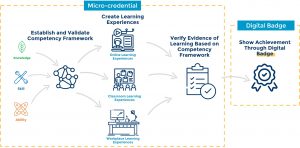
The relationship between learning and work is constantly changing. As someone who has spent their career designing and developing learning experiences, I have personally seen the magnitude and pace of change accelerating in exponential ways. In the book, “Long Life Learning: Preparing for Jobs that Don’t Even Exist Yet,” Michelle Weise explored how changes in the human lifespan and the disruption of work norms likely will have radical implications on the future intersection of learning, education, and work.
The Changing World of Work
As training industry leaders, we are arguably at the epicenter of this change, which will present both challenges and opportunities. If we are to prepare people for jobs that don’t yet exist and design pathways for “life-wide” career changes, we first need to create strategies that help the value propositions of learning experiences become more visible and accessible.
A growing number of training organizations use micro-credentials to certify learning outcomes and achievement; however, we are beginning to see an exciting expansion of applications for micro-credentials on the business side of the organization. For example, organizations are using micro-credentials to drive eligibility for employee scheduling logistics, certify safety verifications, and inform talent management decisions. The development of skill taxonomies in HR technology platforms also provide a logical opportunity to connect micro-credential data to organizational competency models and organizational development strategies.
Invisible Learning
The expansion and development of micro-credentials and digital badges create customizable pathways for people to build agency and ownership in their learning experiences. Micro-credentials provide an attractive alternative to “marathon learning experiences” (e.g., degrees, certification programs) by helping people engage in short, focused, and evidence-based learning experiences that allow them to demonstrate their verified achievements in accessible ways.
Successful micro-credential strategies consider both the design of learning experiences and how outcomes of learning experiences are communicated. Digital badges are a common way through which the achievement of micro-credentials is presented and shared. Digital badges are often thought of as only a graphic, but it’s the digital metadata behind the graphic that describes the learning achievement and enhances its value (Open Badges). This not only helps people to better understand and communicate their learning achievements, it also allows this data about learning achievements to be translated into a machine-readable language. This further expands the reach and value of the micro-credential.
The following graphic illustrates the relationship between competency frameworks/models, micro-credential learning experiences, and digital badges. The competency frameworks are used to inform the design of micro-credential learning experiences, and digital badges are used to communicate evidence-based learning achievements.

Figure 1. Illustration of the relationship between micro-credentials and digital badges.
A Mosaic of Human Capabilities
The ideal outcome of micro-credentials and digital badges is making learning milestones and achievement more visible. When multiple digital badges are earned, they create a personalized “mosaic” of capabilities. This helps people demonstrate their capabilities and plan and create a vision for their future learning experiences. Combining micro-credentials provides an opportunity to “stack” knowledge, skills, and abilities together in personalized ways. This gives people a uniquely personalized way of communicating their capabilities with others. In rapidly shifting economies that are driving new workforce needs, this ability has never been more important.
Designing Micro-Credentials
While micro-credentials and digital badges offer exciting opportunities to connect learning and work, this vision can only be achieved through an intentional strategy and design processes. Creating successful micro-credentials means strategically addressing several design characteristics:
- The Need: Are the knowledge, skills, and abilities included in the micro-credential important in the market?
- The Value: What value does the micro-credential have for people (save time, save/increase money, mitigate risk, achieve recognition, etc.)?
- The Evidence: What evidence is used to demonstrate achievement of competencies?
To incorporate these three essential elements of micro-credentials, the design processes should address the both the concept and structure.
Micro-credential design concepts address core questions about:
- Audience: Who is the micro-credential designed for?
- Drivers: Why is the micro-credential needed?
- Value Proposition: What value does the micro-credential create for people?
- Offering: How will the micro-credential be packaged and delivered to people?
- Competencies: What are the knowledge, skills, and abilities, that make up the micro-credential?
- Name: What will the micro-credential be called?
These conceptual factors must be strong independently, but also be designed to work together. For example, the name of the micro-credential should be easily understood by the audience and communicate the composition of the competencies.
Micro-credentials also are designed based on their structure. The structure of a micro-credential shows the relationship between the competencies, evidence of learning, and the digital badge. This also shows the rules and requirements needed to complete the micro-credential and earn the digital badge.
The conceptual and structural design of micro-credentials work together to create a framework for success. This structure is also aligned with learning evidence. For example, simply attending a seminar would not align with this model, while attending a seminar and developing a reflection or project as evidence of learning would align with the verified micro-credential model.
Collaborations and Co-Design
The training industry is becoming more collaborative and involving a wider array of professionals. Designing micro-credentials is no different, and in many ways, invites us to expand our collaboration networks. In general, designing micro-credentials includes a team of the following people/organizations.
- Sponsor: The sponsor originates the idea for the micro-credential and serves as the “owner” of the micro-credential once available to learners. This may be a school, academy, institute, or other entity that would offer the micro-credential. The sponsor also provides the public brand for the micro-credential and digital badge.
- Design Team: The design team is responsible for facilitating the strategy and design of the micro-credential, modeling the competencies, ensuring alignment of the competencies to evidence, and validating the design against standards and industry trends.
- Content and Industry Experts: Content and industry experts are responsible for providing guidance and decisions about the knowledge, skills, and abilities, that should be included in the micro-credential.
- Verifier: After a person has created evidence of learning for the micro-credential, the verifier is responsible for assessing the evidence of learning in alignment with the established requirements and standards. The person/team ensures the person has successfully demonstrated evidence of learning for the competencies specified.
- Issuer: The issuer is responsible for receiving verification decisions for the micro-credential and issuing the correct digital badge to the earner. The issuer is also responsible for ensuring accuracy in the issuing process and that the proper processes are followed for each digital badge award.
In addition to the roles described, it is vital to incorporate people who would be representative earners of the micro-credentials in the design process. This may include inviting such learners to design sessions or using focus groups or interviews to collect feedback.
Connecting the Future of Learning and Work
Micro-credentials and digital badges most certainly will play a key role in the future of learning and work. A familiar critique of education is that people are rarely prepared to be successful in today’s world of work. This critique will only become more amplified without a focused and strategic pathway to help people develop and communicate in-demand capabilities and engage in lifelong, life-wide learning. As the nature of work changes, the need for strategies such as micro-credentials and digital badges becomes more important.
Resources
https://openbadges.org/
https://trainingmag.com/driving-engagement-through-digital-credentials/

